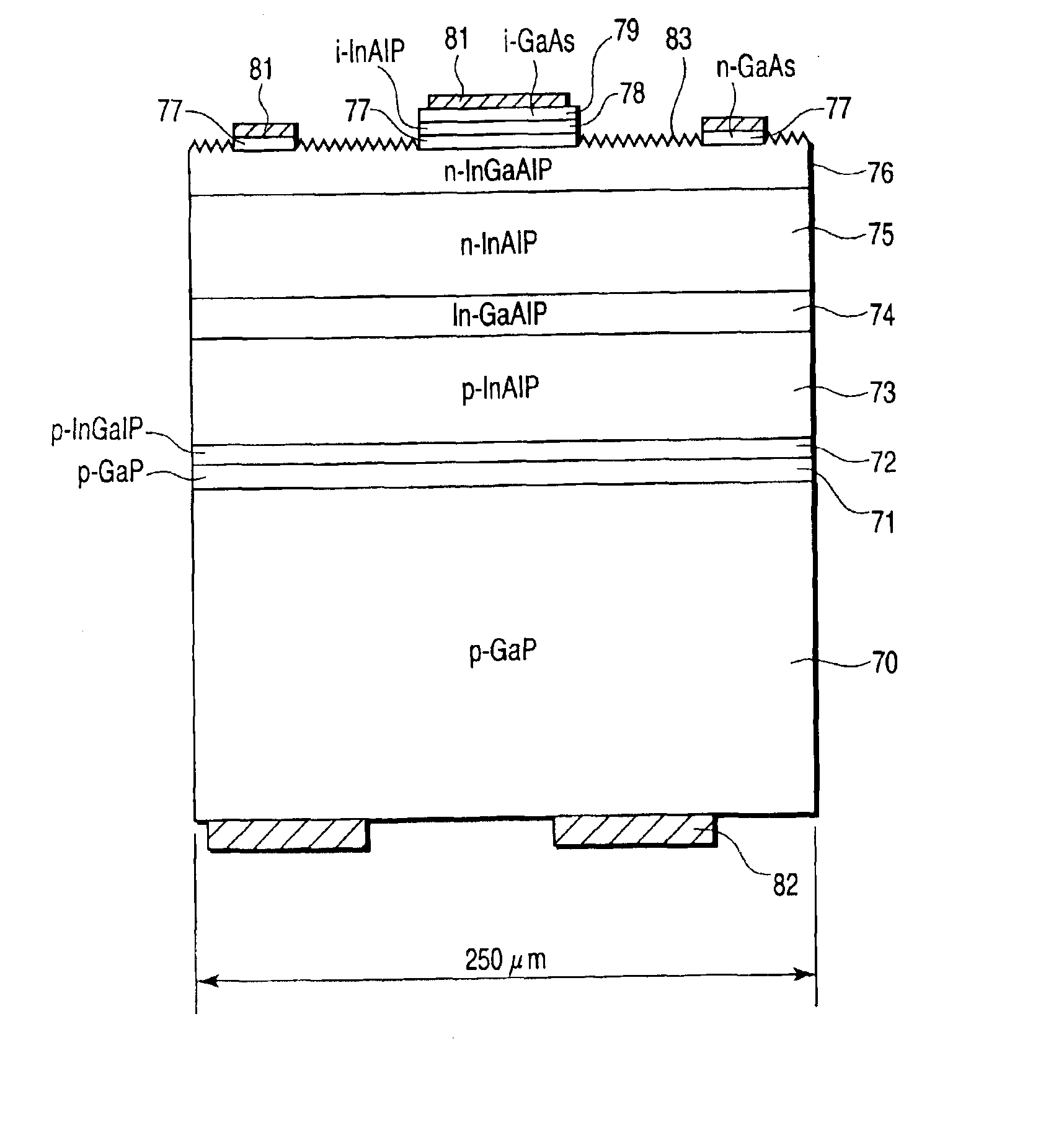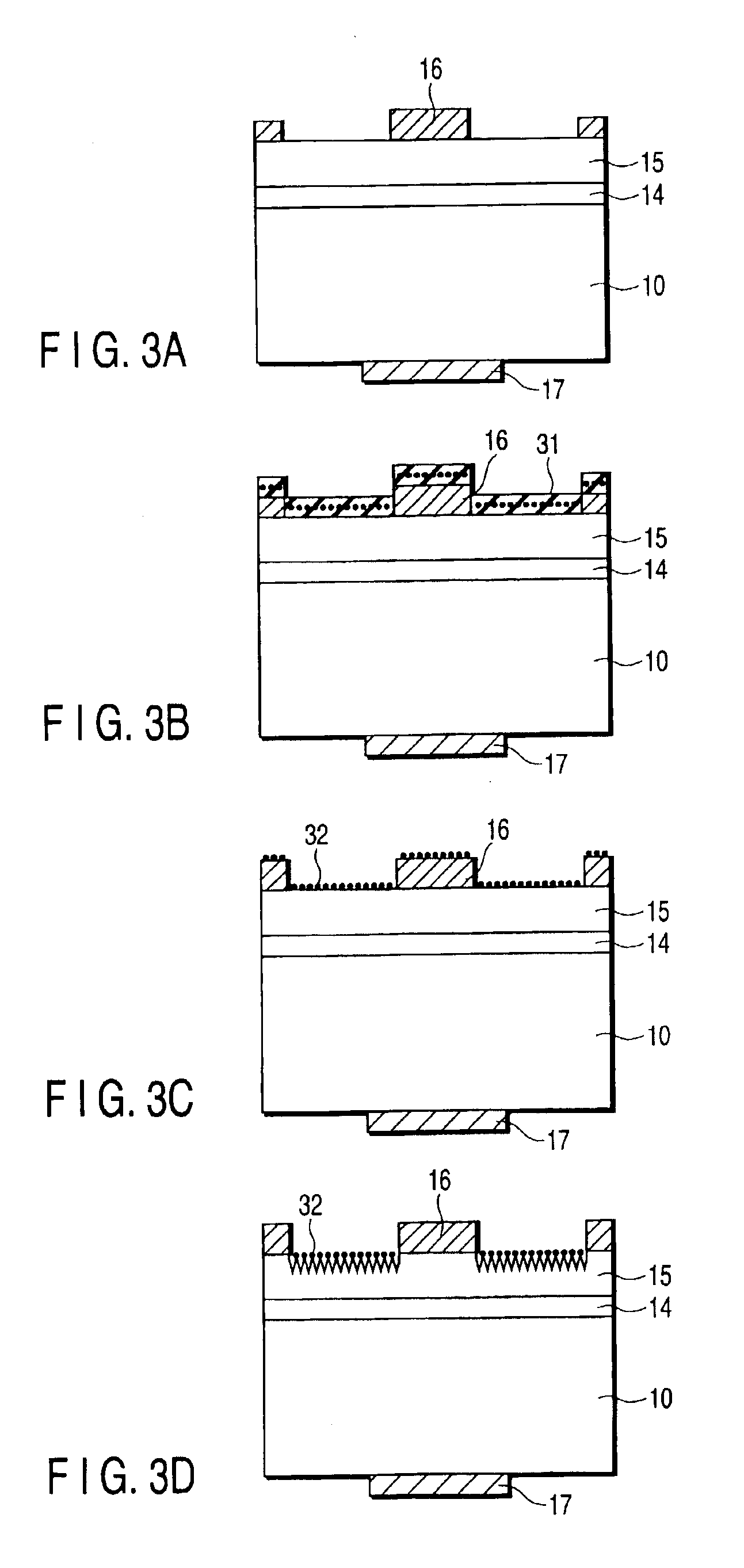Method of manufacturing a semiconductor light-emitting element
a technology of semiconductor light-emitting elements and manufacturing methods, which is applied in the direction of basic electric elements, semiconductor devices, electrical equipment, etc., can solve the problems of affecting the light-emitting diode's luminance, affecting the light-emitting element's probability of light being emitted,
- Summary
- Abstract
- Description
- Claims
- Application Information
AI Technical Summary
Benefits of technology
Problems solved by technology
Method used
Image
Examples
first embodiment
(First Embodiment)
[0032]FIG. 1 is a cross-sectional view illustrating the element structure of an LED according to a first embodiment of the present invention.
[0033]As shown in FIG. 1, on the top surface (the first surface) of an n-type GaP substrate 10 are deposited semiconductor laminated layers comprising a hetero structure portion 14 which is constituted by an n-type InAlP clad layer 11, an InGaAlP activated layer 12 and a p-type InAlP clad layer 13; and a p-type GaP current diffusion layer 15. A p-side electrode (upper electrode) 16 is formed on part of the surface of the current diffusion layer 15 with the remaining portion of the surface of the current diffusion layer 15 being left exposed. On the other hand, an n-side electrode (lower electrode) 17 is formed on the bottom surface (the second surface) of the substrate 10. The light emitted from the activated layer 12 is taken up from the exposed surface of the current diffusion layer 15. Namely, the exposed surface of the cur...
second embodiment
(Second Embodiment)
[0048]A PS pattern was formed by RIE under the same conditions as described in the aforementioned first embodiment except that O2 was substituted for CF4.
[0049]In the same manner as described in the first embodiment, a polymer layer 31 containing a diblock copolymer was formed on the surface of the current diffusion layer 15 and then, the diblock copolymer was subjected to phase separation. Then, the polymer layer 31 was subjected to etching by RIE using O2 gas (30 sccm) under the conditions of 13.3 Pa in pressure and 100 W in power output. In contrast with the etching using CF4, although it was impossible, in this case where O2 was employed, to etch the polymer layer 31 down to the underlying substrate, it was possible to relatively accurately remove the PMMA phase of the PS-PMMA block, thereby forming a PS pattern.
[0050]This PS pattern was then transcribed onto the surface of the current diffusion layer 15 by RIE under the same conditions as described in the afo...
third embodiment
(Third Embodiment)
[0052]In this embodiment, a PS pattern was formed through the scission of the main chain of polymer by the irradiation of electron beam.
[0053]In the same manner as described in the first embodiment, a polymer layer 31 containing a diblock copolymer was formed on the surface of the current diffusion layer 15 and then, the diblock copolymer was subjected to phase separation. Then, an electron beam was irradiated the entire surface of the polymer layer 31 to cut the main chain of PMMA. On this occasion, the conditions of irradiating the electron beam were set to 2 eV. Thereafter, the polymer layer 31 was subjected to development by using a developing solution (for example, a mixed solution comprising MIBK (methylisobutyl ketone) and IPA(isopropanol)). The resultant surface of the polymer layer 31 was then rinsed by IPA or ethanol to selectively dissolve and remove the PMMA, thereby leaving a pattern 32 of PS.
[0054]This PS pattern was then transcribed onto the surface ...
PUM
 Login to View More
Login to View More Abstract
Description
Claims
Application Information
 Login to View More
Login to View More - R&D
- Intellectual Property
- Life Sciences
- Materials
- Tech Scout
- Unparalleled Data Quality
- Higher Quality Content
- 60% Fewer Hallucinations
Browse by: Latest US Patents, China's latest patents, Technical Efficacy Thesaurus, Application Domain, Technology Topic, Popular Technical Reports.
© 2025 PatSnap. All rights reserved.Legal|Privacy policy|Modern Slavery Act Transparency Statement|Sitemap|About US| Contact US: help@patsnap.com



